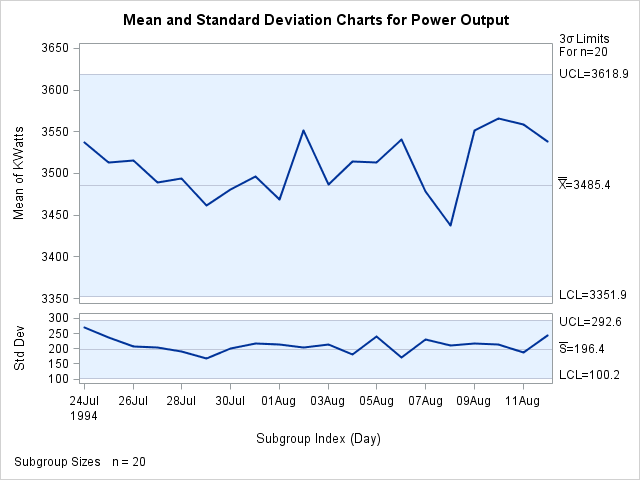XSCHART Statement: SHEWHART Procedure
Reading Preestablished Control Limits
Note: See Mean and Standard Deviation Charts Examples in the SAS/QC Sample Library.
In the previous example, the OUTLIMITS= data set Turblim saved control limits computed from the measurements in Turbine. This example shows how these limits can be applied to new data. The following statements create  and s charts for new measurements in a data set named
and s charts for new measurements in a data set named Turbine2 (not listed here) using the control limits in Turblim:
ods graphics on; title 'Mean and Standard Deviation Charts for Power Output'; proc shewhart data=Turbine2 limits=Turblim; xschart KWatts*Day / odstitle = title; run;
The ODS GRAPHICS ON statement specified before the PROC SHEWHART statement enables ODS Graphics, so the  and s charts are created by using ODS Graphics instead of traditional graphics. The charts are shown in Figure 18.121.
and s charts are created by using ODS Graphics instead of traditional graphics. The charts are shown in Figure 18.121.
The LIMITS= option in the PROC SHEWHART statement specifies the data set containing preestablished control limit information. By default, this information is read from the first observation in the LIMITS= data set for which
-
the value of
_VAR_matches the process nameKWatts -
the value of
_SUBGRP_matches the subgroup-variable nameDay
Figure 18.121:  and s Charts for Second Set of Power Outputs (ODS Graphics)
and s Charts for Second Set of Power Outputs (ODS Graphics)

The means and standard deviations lie within the control limits, indicating that the heating process is still in statistical control.
In this example, the LIMITS= data set was created in a previous run of the SHEWHART procedure. You can also create a LIMITS= data set with the DATA step. See LIMITS= Data Set for details concerning the variables that you must provide.
